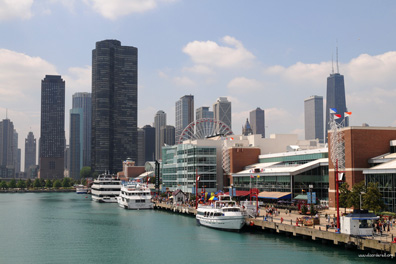 REVITALIZATION AND REDEVELOPMENT
REVITALIZATION AND REDEVELOPMENTChicago:
Navy Pier
WHAT IS IT?
Navy Pier is on the lakefront property of Lake Michigan. It combines the shipping business with recreational and entertainment activities. It encompasses more than 50 acres of parks, gardens, shops, restaurants and other entertainment. The Navy Pier contains 170,000 total square feet of exhibition space, 50,000 square feet of reception space and 48,000 square feet of meeting room space. Several business conventions, art shows, and public festivals occur at the pier annually. Families can enjoy the Children’s Museum, the Skyline Stage outdoor theater, Crystal Garden indoor park, as well as an IMAX theater all located at the pier.
HISTORY (1916)…DEVELOPMENT
The Pier opened to the public in 1916 and 4.5 million dollars later it was a thriving public meeting place. It was a great success because it incorporated business with recreation. Also, it was easily accessible to the public enabling people to flock to the area.
WORLD WAR I AND AFTER
During World War I, the Navy Pier continued to be a popular destination spot and the city helped its accessibility by adding its own streetcar, theater and restaurants. However, during World War I the pier also functioned as a military information center by housing the Red Cross, Home Defenses and other military units.
THE 1920s
The Navy Pier hosted the "Pageant of Progress" during which the pier had more than a million visitors within a few days. The 20’s were considered the pier’s "Golden Age" due to the high attendance. It is estimated that 3.2 million visitors frequented the pier annually.
THE DEPRESSION
Throughout the Depression, the pier was still popular, but lighter freight and passenger traffic was experienced as result of the poor economic times. The success of the pier continued through the start of World War II.
WORLD WAR II
The city leased the pier to the Navy during World War II. At this time, 60,000 soldiers as well as 15,000 pilots used this area for training. It was not available for public use.
POST WORLD WAR II
The University of Illinois established a two-year branch campus at the pier just after the end of World War II. The great public gathering place the pier used to function as had changed its identity and function.
1970s 1980s
The Navy Pier fell into disuse after the University of Illinois was not using the facilities anymore. The area became an eyesore to the people of Chicago. It was a symbol of the declining, decaying urban area. Many efforts were made in attempt to restore parts of the pier by government agencies, but none were successful.
 REVITALIZATION AND REDEVELOPMENT
REVITALIZATION AND REDEVELOPMENT
In 1989, the Metropolitan Pier and Exposition Authority obtained ownership of the pier in hopes of revitalizing it. The Authority quickly acted to redesign the Navy Pier into one of the country most unique recreation and exposition facility. One million people visit per month and it is considered Chicago’s most popular year-round destination (Drell 1996).
The housing near the pier has experienced a boom. City officials hope that the thriving pier may spur revitalization in the Chicago housing core near the area (McCarron 97). There is also discussion about extending the walkway two miles south. City planners hope a riverwalk along the South Branch would become part of a continuous walkway from the Navy Pier to Chinatown. This plan envisions the continuation of the Pier’s success into other dilapidated parts of the city (Kaiser 1997).
PROBLEMS AND SUCCESSES
The recent renovations of the Navy Pier came with many compromises. Structures were torn down that were part of the original structures. As a result, the pier is no longer on the National Register of Historic Places (Reardon 1992).
The new Navy Pier is still huge success. People still flock there by the millions for recreation and entertainment. Theater companies and other types of entertainment and retail continue to try to locate there because the numbers of people there is huge (Jones 1998). The Navy Pier is a successful marriage of preservation and development. It is an excellent showcase of how a rundown area can be turned around.
Bibliography
Adrienne Drell, "Lakefront Battle," Chicago Sun-Times, september 15, 1996 p.11 Chris Jones, "The location is the thing Chicago’s Shakespeare Rep poised for move to Navy Pier, and Perhaps for Wider Recognition," Chicago Tribune, February 1, 1998, p.16Robert L. Kaiser, "Blazing a Trail Through Lost Chicago," Chicago Tribune, August 5, 1997, p.1
John McCarron, "Downtown Unchained? The Building Boom Is Back, " Chicago Tribune, August 11, 1997, p 1D, col. 2-3
Patrick Reardon, "Navy Pier Off U.S. Historic List, " Chicago Tribune, February 18, 1992, p 2C,col.2-4
www.navypier.com Navy Pier homepage
Web Author: Angela Peecher
| Physical Strategies | Functional Strategies |
|---|
.
